- Home
- Anthony Doerr
Memory Wall
Memory Wall Read online
Also by Anthony Doerr
The Shell Collector
About Grace
Four Seasons in Rome
Scribner
A Division of Simon & Schuster, Inc.
1230 Avenue of the Americas
New York, NY 10020
www.SimonandSchuster.com
This book is a work of fiction. Names, characters, places, and incidents either are products of the author’s imagination or are used fictitiously. Any resemblance to actual events or locales or persons, living or dead, is entirely coincidental.
Copyright © 2010 by Anthony Doerr
All rights reserved, including the right to reproduce this book or portions thereof in any form whatsoever. For information address Scribner Subsidiary Rights
Department, 1230 Avenue of the Americas, New York, NY 10020.
First Scribner hardcover edition July 2010
SCRIBNER and design are registered trademarks of The Gale Group, Inc., used under license by Simon & Schuster, Inc., the publisher of this work.
For information about special discounts for bulk purchases,
please contact Simon & Schuster Special Sales at
1-866-506-1949 or [email protected].
The Simon & Schuster Speakers Bureau can bring authors to your live event. For more information or to book an event, contact the Simon & Schuster Speakers Bureau at 1-866-248-3049 or visit our website at www.simonspeakers.com.
Designed by Carla Jayne Jones
Manufactured in the United States of America
1 3 5 7 9 10 8 6 4 2
Library of Congress Control Number: 2009052245
ISBN 978-1-4391-8280-2
ISBN 978-1-4391-8285-7 (ebook)
Some of the stories in this collection have appeared elsewhere, in slightly different form: “Memory Wall” and “Afterworld” in McSweeney’s; “Procreate, Generate” in Granta; “Village 113” in Tin House and The O. Henry Prize Stories 2008; and “The River Nemunas” in Tin House.
For Shauna
Contents
Memory Wall
Procreate, Generate
The Demilitarized Zone
Village 113
The River Nemunas
Afterworld
You have to begin to lose your memory, if only in bits and pieces, to realize that memory is what makes our lives. Life without memory is no life at all, just as an intelligence without the possibility of expression is not really an intelligence. Our memory is our coherence, our reason, our feeling, even our action. Without it, we are nothing.
—LUIS BUÑUEL, MY LAST SIGH
Memory Wall
TALL MAN IN THE YARD
Seventy-four-year-old Alma Konachek lives in Vredehoek, a suburb above Cape Town: a place of warm rains, big-windowed lofts, and silent, predatory automobiles. Behind her garden, Table Mountain rises huge, green, and corrugated; beyond her kitchen balcony, a thousand city lights wink and gutter behind sheets of fog like candleflames.
One night in November, at three in the morning, Alma wakes to hear the rape gate across her front door rattle open and someone enter her house. Her arms jerk; she spills a glass of water across the nightstand. A floorboard in the living room shrieks. She hears what might be breathing. Water drips onto the floor.
Alma manages a whisper. “Hello?”
A shadow flows across the hall. She hears the scrape of a shoe on the staircase, then nothing. Night air blows into the room—it smells of frangipani and charcoal. Alma presses a fist over her heart.
Beyond the balcony windows, moonlit pieces of clouds drift over the city. Spilled water creeps toward her bedroom door.
“Who’s there? Is someone there?”
The grandfather clock in the living room pounds through the seconds. Alma’s pulse booms in her ears. Her bedroom seems to be rotating very slowly.
“Harold?” Alma remembers that Harold is dead but she cannot help herself. “Harold?”
Another footstep from the second floor, another protest from a floorboard. What might be a minute passes. Maybe she hears someone descend the staircase. It takes her another full minute to summon the courage to shuffle into the living room.
Her front door is wide open. The traffic light at the top of the street flashes yellow, yellow, yellow. The leaves are hushed, the houses dark. She heaves the rape gate shut, slams the door, sets the bolt, and peers out the window lattice. Within twenty seconds she is at the hall table, fumbling with a pen.
A man, she writes. Tall man in the yard.
MEMORY WALL
Alma stands barefoot and wigless in the upstairs bedroom with a flashlight. The clock down in the living room ticks and ticks, winding up the night. A moment ago Alma was, she is certain, doing something very important. Something life-and-death. But now she cannot remember what it was.
The one window is ajar. The guest bed is neatly made, the coverlet smooth. On the nightstand sits a machine the size of a microwave oven, marked Property of Cape Town Memory Research Center. Three cables spiraling off it connect to something that looks vaguely like a bicycle helmet.
The wall in front of Alma is smothered with scraps of paper. Diagrams, maps, ragged sheets swarming with scribbles. Shining among the papers are hundreds of plastic cartridges, each the size of a matchbook, engraved with a four-digit number and pinned to the wall through a single hole.
The beam of Alma’s flashlight settles on a color photograph of a man walking out of the sea. She fingers its edges. The man’s pants are rolled to the knees; his expression is part grimace, part grin. Cold water. Across the photo, in handwriting she knows to be hers, is the name Harold. She knows this man. She can close her eyes and recall the pink flesh of his gums, the folds in his throat, his big-knuckled hands. He was her husband.
Around the photo, the scraps of paper and plastic cartridges build outward in crowded, overlapping layers, anchored with pushpins and chewing gum and penny nails. She sees to-do lists, jottings, drawings of what might be prehistoric beasts or monsters. She reads: You can trust Pheko. And Taking Polly’s Coca-Cola. A flyer says: Porter Properties. There are stranger phrases: dinocephalians, late Permian, massive vertebrate graveyard. Some sheets of paper are blank; others reveal a flurry of cross-outs and erasures. On a half-page ripped from a brochure, one phrase is shakily and repeatedly underlined: Memories are located not inside the cells but in the extracellular space.
Some of the cartridges have her handwriting on them, too, printed below the numbers. Museum. Funeral. Party at Hattie’s.
Alma blinks. She has no memory of writing on little cartridges or tearing out pages of books and tacking things to the wall.
She sits on the floor in her nightgown, legs straight out. A gust rushes through the window and the scraps of paper come alive, dancing, tugging at their pins. Loose pages eddy across the carpet. The cartridges rattle lightly.
Near the center of the wall, her flashlight beam again finds the photograph of a man walking out of the sea. Part grimace, part grin. That’s Harold, she thinks. He was my husband. He died. Years ago. Of course.
Out the window, beyond the crowns of the palms, beyond the city lights, the ocean is washed in moonlight, then shadow. Moonlight, then shadow. A helicopter ticks past. The palms flutter.
Alma looks down. There is slip of paper in her hand. A man, it says. Tall man in the yard.
DR. AMNESTY
Pheko is driving the Mercedes. Apartment towers reflect the morning sun. Sedans purr at stoplights. Six different times Alma squints out at the signs whisking past and asks him where they are going.
“We’re driving to see the doctor, Mrs. Alma.”
The doctor? Alma rubs her eyes, unsure. She tries to fill her lungs. She fidgets with her wig. The tires squeal as the Mercedes climb
s the ramps of a parking garage.
Dr. Amnesty’s staircase is stainless steel and bordered with ferns. Here’s the bulletproof door, the street address stenciled in the corner. It’s familiar to Alma in the way a house from childhood would be familiar. As if she has doubled in size in the meantime.
They are buzzed into a waiting room. Pheko drums his fingertips on his knee. Four chairs down, two well-dressed women sit beside a fish tank, one a few decades younger than the other. Both have fat pearls studded through each earlobe. Alma thinks: Pheko is the only black person in the building. For a moment she cannot remember what she is doing here. But this leather on the chair, the blue gravel in the saltwater aquarium—it is the memory clinic. Of course. Dr. Amnesty. In Green Point.
After a few minutes Alma is escorted to a padded chair overlaid with crinkly paper. It’s all familiar now: the cardboard pouch of rubber gloves, the plastic plate for her earrings, two electrodes beneath her blouse. They lift off her wig, rub a cold gel onto her scalp. The television panel shows sand dunes, then dandelions, then bamboo.
Amnesty. A ridiculous surname. What does it mean? A pardon? A reprieve? But more permanent than a reprieve, isn’t it? Amnesty is for wrongdoings. For someone who has done something wrong. She will ask Pheko to look it up when they get home. Or maybe she will remember to look it up herself.
The nurse is talking.
“And the remote stimulator is working well? Do you feel any improvements?”
“Improvements?” She thinks so. Things do seem to be improving. “Things are sharper,” Alma says. She believes this is the sort of thing she is supposed to say. New pathways are being forged. She is remembering how to remember. This is what they want to hear.
The nurse murmurs. Feet whisper across the floor. Invisible machinery hums. Alma can feel, numbly, the rubber caps being twisted out of the ports in her skull and four screws being threaded simultaneously into place. There is a note in her hand: Pheko is in the waiting room. Pheko will drive Mrs. Alma home after her session. Of course.
A door with a small, circular window in it opens. A pale man in green scrubs sweeps past, smelling of chewing gum. Alma thinks: There are other padded chairs in this place, other rooms like this one, with other machines prying the lids off other addled brains. Ferreting inside them for memories, engraving those memories into little square cartridges. Attempting to fight off oblivion.
Her head is locked into place. Aluminum blinds clack against the window. In the lulls between breaths, she can hear traffic sighing past.
The helmet comes down.
THREE YEARS BEFORE, BRIEFLY
“Memories aren’t stored as changes to molecules inside brain cells,” Dr. Amnesty told Alma during her first appointment, three years ago. She had been on his waiting list for ten months. Dr. Amnesty had straw-colored hair, nearly translucent skin, and invisible eyebrows. He spoke English as if each word were a tiny egg he had to deliver carefully through his teeth.
“This is what they thought forever but they were wrong. The truth is that the substrate of old memories is located not inside the cells but in the extracellular space. Here at the clinic we target those spaces, stain them, and inscribe them into electronic models. In the hopes of teaching damaged neurons to make proper replacements. Forging new pathways. Re-remembering.
“Do you understand?”
Alma didn’t. Not really. For months, ever since Harold’s death, she had been forgetting things: forgetting to pay Pheko, forgetting to eat breakfast, forgetting what the numbers in her checkbook meant. She’d go to the garden with the pruners and arrive there a minute later without them. She’d find her hairdryer in a kitchen cupboard, car keys in the tea tin. She’d rummage through her mind for a noun and come up empty-handed: Casserole? Carpet? Cashmere?
Two doctors had already diagnosed the dementia. Alma would have preferred amnesia: a quicker, less cruel erasure. This was a corrosion, a slow leak. Seven decades of stories, five decades of marriage, four decades of working for Porter Properties, too many houses and buyers and sellers to count—spatulas and salad forks, novels and recipes, nightmares and daydreams, hellos and goodbyes. Could it all really be wiped away?
“We don’t offer a cure,” Dr. Amnesty was saying, “but we might be able to slow it down. We might be able to give you some memories back.”
He set the tips of his index fingers against his nose and formed a steeple. Alma sensed a pronouncement coming.
“It tends to unravel very quickly, without these treatments,” he said. “Every day it will become harder for you to be in the world.”
Water in a vase, chewing away at the stems of roses. Rust colonizing the tumblers in a lock. Sugar eating at the dentin of teeth, a river eroding its banks. Alma could think of a thousand metaphors, and all of them were inadequate.
She was a widow. No children, no pets. She had her Mercedes, a million and a half rand in savings, Harold’s pension, and the house in Vredehoek. Dr. Amnesty’s procedure offered a measure of hope. She signed up.
The operation was a fog. When she woke, she had a headache and her hair was gone. With her fingers she probed the four rubber caps secured into her skull.
A week later Pheko drove her back to the clinic. One of Dr. Amnesty’s nurses escorted her to a leather chair that looked something like the ones in dental offices. The helmet was merely a vibration at the top of her scalp. They would be reclaiming memories, they said; they could not predict if the memories would be good ones or bad ones. It was painless. Alma felt as though spiders were stringing webs though her head.
Two hours later Dr. Amnesty sent her home from that first session with a remote memory stimulator and nine little cartridges in a paperboard box. Each cartridge was stamped from the same beige polymer, with a four-digit number engraved into the top. She eyed the remote player for two days before taking it up to the upstairs bedroom one windy noon when Pheko was out buying groceries.
She plugged it in and inserted a cartridge at random. A low shudder rose through the vertebrae of her neck, and then the room fell away in layers. The walls dissolved. Through rifts in the ceiling, the sky rippled like a flag. Then Alma’s vision snuffed out, as if the fabric of her house had been yanked downward through a drain, and a prior world rematerialized.
She was in a museum: high ceiling, poor lighting, a smell like old magazines. The South African Museum. Harold was beside her, leaning over a glass-fronted display, excited, his eyes shining—look at him! So young! His khakis were too short, black socks showed above his shoes. How long had she known him? Maybe six months?
She had worn the wrong shoes: tight, too rigid. The weather had been perfect that day and Alma would have preferred to sit in the Company Gardens under the trees with this tall new boyfriend. But the museum was what Harold wanted and she wanted to be with him. Soon they were in a fossil room, a couple dozen skeletons on podiums, some as big as rhinos, some with yardlong fangs, all with massive, eyeless skulls.
“One hundred and eighty million years older than the dinosaurs, hey?” Harold whispered.
Nearby, schoolgirls chewed gum. Alma watched the tallest of them spit slowly into a porcelain drinking fountain, then suck the spit back into her mouth. A sign labeled the fountain For Use by White Persons in careful calligraphy. Alma felt as if her feet were being crushed in vises.
“Just another minute,” Harold said.
Seventy-one-year-old Alma watched everything through twenty-four-year-old Alma. She was twenty-four-year-old Alma! Her palms were damp and her feet were aching and she was on a date with a living Harold! A young, skinny Harold! He raved about the skeletons; they looked like animals mixed with animals, he said. Reptile heads on dog bodies. Eagle heads on hippo bodies. “I never get tired of seeing them,” young Harold was telling young Alma, a boyish luster in his face. Two hundred and fifty million years ago, he said, these creatures died in the mud, their bones compressed slowly into stone. Now someone had hacked them out; now they were reassembled in the light.
“These were our ancestors, too,” Harold whispered. Alma could hardly bear to look at them: They were eyeless, fleshless, murderous; they seemed engineered only to tear one another apart. She wanted to take this tall boy out to the gardens and sit hip-to-hip with him on a bench and take off her shoes. But Harold pulled her along. “Here’s the gorgonopsian. A gorgon. Big as a tiger. Two, three hundred kilograms. From the Permian. That’s only the second complete skeleton ever found. Not so far from where I grew up, you know.” He squeezed Alma’s hand.
Alma felt dizzy. The monster had short, powerful legs, fist-size eyeholes, and a mouth full of fangs. “Says they hunted in packs,” whispered Harold. “Imagine running into six of those in the bush?” In the memory twenty-four-year-old Alma shuddered.
“We think we’re supposed to be here,” he continued, “but it’s all just dumb luck, isn’t it?” He turned to her, about to explain, and as he did shadows rushed in from the edges like ink, flowering over the entire scene, blotting the vaulted ceiling, and the schoolgirl who’d been spitting into the fountain, and finally young Harold himself in his too small khakis. The remote device whined; the cartridge ejected; the memory crumpled in on itself.
Alma blinked and found herself clutching the footboard of her guest bed, out of breath, three miles and five decades away. She unscrewed the headgear. Out the window a thrush sang chee-chweeeoo. Pain swung through the roots of Alma’s teeth. “My god,” she said.
THE ACCOUNTANT
That was three years ago. Now a half dozen doctors in Cape Town are harvesting memories from wealthy people and printing them on cartridges, and occasionally the cartridges are traded on the streets. Old-timers in nursing homes, it’s been reported, are using memory machines like drugs, feeding the same ratty cartridges into their remote machines: wedding night, spring afternoon, bike-ride-along-the-cape. The little plastic squares smooth and shiny from the insistence of old fingers.

 All the Light We Cannot See
All the Light We Cannot See About Grace
About Grace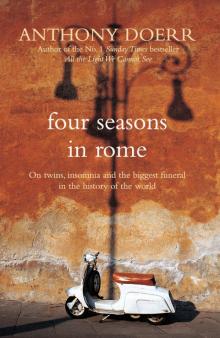 Four Seasons in Rome: On Twins, Insomnia, and the Biggest Funeral in the History of the World
Four Seasons in Rome: On Twins, Insomnia, and the Biggest Funeral in the History of the World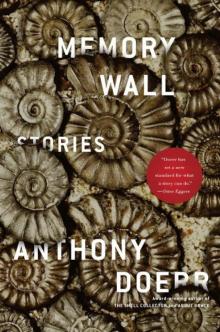 Memory Wall
Memory Wall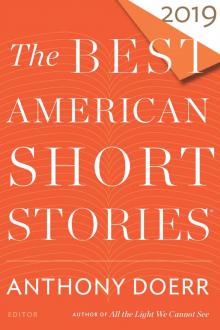 The Best American Short Stories 2019
The Best American Short Stories 2019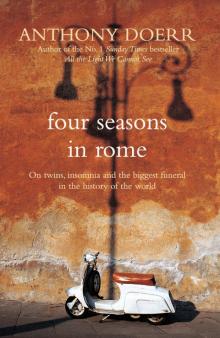 Four Seasons in Rome
Four Seasons in Rome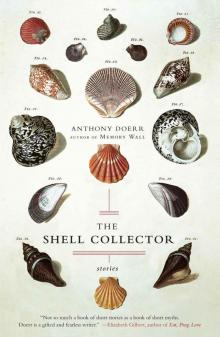 The Shell Collector
The Shell Collector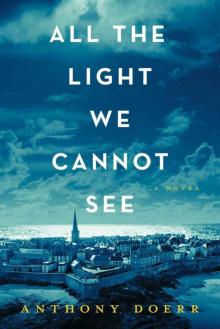 All the Light We Cannot See: A Novel
All the Light We Cannot See: A Novel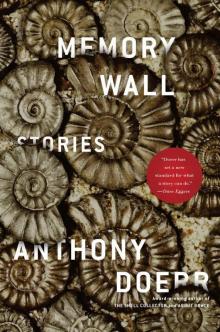 Memory Wall: Stories
Memory Wall: Stories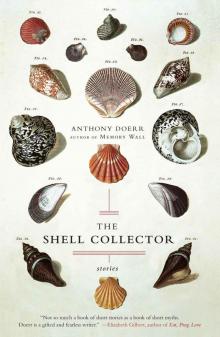 Shell Collector
Shell Collector